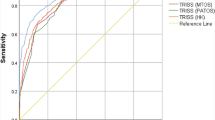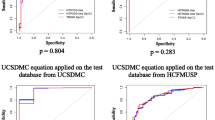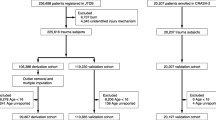Abstract
Objective
To validate the TRISS method as an audit system on a group of patients with severe trauma admitted to an Italian general intensive care unit (ICU).Design: Prospective, cohort study of consecutive admissions to the ICU.
Setting
A 6-bed general ICU in a 500-bed general hospital.Patients: 190 patients with severe trauma admitted from January 1992 to December 1993 were considered eligible. Patients lacking the data necessary to calculate the TRISS probability of survival, or for whom the ultimate outcome was unknown, were excluded. 162 patients were included in the study.
Interventions
None.
Outcome measure
Vital status at discharge from the last hospital that admitted the patient for the trauma being considered.
Results
The Hosmer-Lemeshow goodness-of-fit tests were: Ĥ=16.9,df=10,p=0.076; Ĉ=5.8,df=10,p=0.831; Ĥ 3.5,df=3,p=0.31. The area under the receiver operating characteristic curve was 0.963 (SE±0.019). Classification measures at a decision criterion of 0.5 were: sensitivity 0.857, specificity 0.964, positive predictive value 0.782, negative predictive value 0.978, total correct classification 0.950, and the Youden index 0.821. The positive likelihood ratio (LHR) was 24.17, whereas the negative LHR was 0.14.
Conclusions
The results of the validation of the TRISS method showed adequate calibration and high discriminatory power in Italian ICU trauma patients also, allowing confidence in the use of this method as an audit tool in our ICU. Some caution is advisable in extending these results to patients with operable intracranial injuries, due to the relatively low number of such cases included in the study.
Similar content being viewed by others
References
Lemeshow S, Le Gall J-R (1994) Modeling the severity of illness of ICU patients. A systems update. JAMA 272: 1049–1055
Knaus WA, Draper EA, Wagner DP, Zimmerman JE (1985) APACHE II: a severity of disease classification system. Crit Care Med 13:818–829
Vassar MJ, Wilkerson CL, Duran PJ, Perry CA, Holcroft JW (1992) Comparison of APACHE II, TRISS and a proposed 24-hour ICU point system for prediction of outcome in ICU trauma patients. J Trauma 32:490–499
McAnena OJ, Moore FA, Moore EE, Mattox KL, Marx JA, Pepe P (1992) Invalidation of the APACHE II scoring system for patients with acute trauma. J Trauma 33:504–507
Boyd CR, Tolson MA, Copes WS (1987) Evaluating trauma care: the TRISS method. J Trauma 27:370–378
Wardrope J, Cross SF, Fothergill DJ (1990) One year's experience of major trauma outcome study methodology. BMJ 301:156–159
Ingham Clark CL, Tabone Vassallo M (1991) Major trauma: a district general hospital experience. Br J Surg 78: 230–233
Waddell TK, Kalman PG, Goodman SJL, Girotti MJ (1991) Is outcome worse in a small volume Canadian trauma centre? J Trauma 31:958–961
Crawford R (1991) Trauma audit: experience in north-east Scotland. Br J Surg 78: 1362–1366
Schmidt U, Muggia Sullam M, Holch M, Kant CJ, Brummerloh C, Frame SB, Rowe DW, Enderson BL, Nerlich M, Maull KI (1993) Primarversorgung des Polytraumas. Vergleich eines deutschen und amerikanischen Luftrettungssystems. Unfallchirurg 96:287–291
King PM, Tucker WS, Waddell JP, Brown T (1994) Correlation of trauma scoring and outcome in a Canadian trauma centre. Can J Surg 37:185–188
Cvetkovic A (1992) TRISS analysis of trauma care: a Yugoslave perspective. Injury 23: 511–514
Suárez-Alvarez JR, Miquel J, Del Río FJ, Ortega P (1995) Epidemiologic aspects and results of applying the TRISS methodology in a Spanish trauma intensive care unit (TICU). Intensive Care Med 21: 729–736
Jones JM, Redmond AD, Templeton J (1995) Uses and abuses of statistical models for evaluating trauma care. J Trauma 38: 89–93
Jones JM (1995) An approach to the analysis of trauma data having a response variable of death or survival. J Trauma 38:123–128
Gordini D, Feoli A, Pasini T, Vinelli M (1992) I traumi cranici ed il soccorso extrospedaliero. Valutazione dell'efficacia del trattamento precoce. Minerva Anestesiol 58: 217–220
Teasdale G, Jennett B (1974) Assesment of coma and impaired consciousness. A practical scale. Lancet II: 81–84
American Association for Automotive Medicine (1985). The abbreviated injury scale, 1985 rev. AAAM, Arlington Heights IL
Civil ID, Schwab CW (1988) The Abbreviated Injury Scale, 1985 revison: a condensed scoring chart for clinical use. J Trauma 28: 87–90
Hosmer DW, Lemeshow S (1989) Applied logistic regression. Wiley, New York
Le Gall J-R, Lemeshow S, Saulnier F (1993) A new Simplified Acute Physiology Score (SAPS II) based on a European/North American multicenter study. JAMA 270: 2957–2963
Lemeshow S, Hosmer DW (1982) A review of goodness of fit statistics for use in the development of logistic regression models. Am J Epidemiol 115: 92–106
Snedecor GW, Cochrane WG (1989) Statistical methods, 8th ed. Iowa State University Press, Ames, IA, pp 77–78
Lett RR, Hanley JA, Smith JS (1995) The comparison of injury severity instrument performance using likelihood ratio and ROC curve analyses. J Trauma 38: 142–148
Sackett DL, Haynes RB, Tugwell P (1985) Clinical epidemiology: a basic science for clinical medicine. Little, Brown, Boston Toronto, pp 59–138
Hanley JA, McNeil BJ (1982) The meaning and use of the area under a Receiver Operating Characteristic (ROC) curve radiology 143: 29–36
West JG, Cales RH, Gazzaniga AB (1983) Impact of regionalization: the Orange County experience. Arch Surg 118: 740–744
West JG, Trunkey DD, Lim RC (1979) Systems of trauma care: a study of two counties. Arch Surg 114: 455–460
Karsteadt LL, Larsen CL, Farmer PD (1994) Analysis of a rural trauma program using the TRISS methodology: a three-year retrospective study. J Trauma 36: 395–400
Rowan KM, Kerr JH, Major E, McPherson K, Short A, Vessey MP (1993) Intensive Care Society's APACHE II study in Britain and Ireland-II: outcome comparisons of intensive care units after adjustment for case mix by American APACHE II method. BMJ 307: 977–981
Bone RC, McElwee NE, Eubanks DH, Gluck EH (1993) Analysis of indications for early discharge from the intensive care unit. Clinical efficacy assessment project: American College of Physicians. Chest 104: 1812–1817
Author information
Authors and Affiliations
Rights and permissions
About this article
Cite this article
Corbanese, U., Possamai, C., Casagrande, L. et al. Evaluation of trauma care: Validation of the TRISS method in an Italian ICU. Intensive Care Med 22, 941–946 (1996). https://doi.org/10.1007/BF02044120
Received:
Accepted:
Issue Date:
DOI: https://doi.org/10.1007/BF02044120




